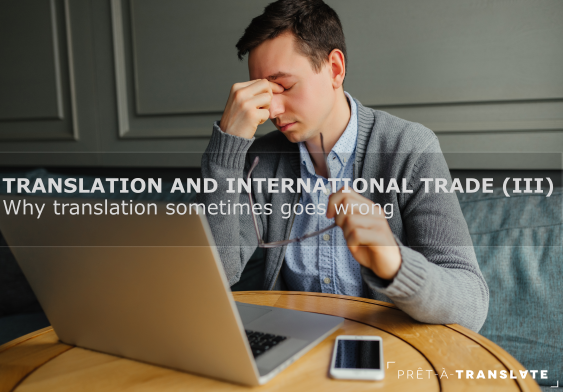
Translation and international trade (III)
Why translation sometimes goes wrong
Better late than never! I am sorry for taking so long to write this post, but luckily I have many loyal clients and the work doesn’t stop coming in at the moment! First things first, deadlines come before blog writing!
Today, I have finally been able to get back to this series on translation and international trade with the last, and possibly the most useful post: how to avoid problems when translating the documents we use in our import, export and internationalisation activities.

Translation issues
Organisational issues: we may work from home, but we’re not alone
Many of us translators have an office at home, that’s a given. And no, we don’t work in our pyjamas. OK, we do sometimes. However, thanks to technology, this doesn’t stop us from feeling like we are part of a team. Many translation issues occur because of a lack of communication.
If we translators could choose one favourite word, it would probably be context. Translating without any context is like speaking to a brick wall: it’s a waste of time. That’s why we need you to give us some information about the text that you want translated, like who is going to read the translation or what format the translation is going to be in. With this information, we can make sure the translation is correct and that it meets its objective.
Also, don’t be surprised if a translator asks you questions. Remember that we are not walking dictionaries and no matter how specialised we may be in a specific subject matter, you know your company, product and services better than anyone. So, let us be part of your team.
Linguistic issues: spelling mistakes are not en vogue, even if Google accepts them
End of. Google realises that some people search for words with spelling mistakes, but that doesn’t mean that you should use them in any of your company’s content. Why? 1. It can give you a bad name. Your target audience could be led to believe that your company is not very professional, is careless and doesn’t pay attention to detail (all important points that need looking after if you want to build trust with potential clients). 2. Spelling mistakes can cause readers to misunderstand, and therefore, misinterpret your text, leading to an incorrect translation.
The same happens when commas or accents (in Spanish) are not used correctly. Grammar Girl may be a useful blog to improve your English writing.
Typos that may seem insignificant can change the meaning of a whole sentence.
Although we do love a good old pun or play-on-words, try to avoid using them in texts that you are going to translate because they do not always transfer so easily into another language.
Really long sentences with many subordinate clauses can cause translation problems too. Remember: brevity is the soul of wit.
Cultural issues: when in Rome, do as the Romans do
It is a common school of thought that the translator needs to keep the target culture in mind if they want their text to read like an original text and not a translation.
This means that we sometimes have to change cultural references for others that sound more natural in the target language or even omit them.
Companies that export their products or set up in other countries could encounter huge conflicts with their local partners or even their employees if they don’t consider cultural differences.
Some years ago, I came across one of these cases when I was editing a translation. It was a workers’ manual for a North American company and it mentioned that employees could not “engage in solicitation and distribution activities”. The translator understood that the company was banning employees from “engaging in prostitution”, when it was actually referring to directly selling cosmetics, raffle tickets or biscuits in working hours. Since this wasn’t very usual in Spain, the translator didn’t twig that it was a common occurrence in the States.
Other cultural issues include religious references, numbers and colours that can be good or bad luck or references to historical figures with a positive or negative reputation, depending on the target country.
How to avoid putting your foot in it
If you want your international strategy to steer clear of linguistic and cultural issues, I have one simple piece of advice: before you start, surround yourself with business experts in your target country, research the market to pinpoint who your target audience is and identify any changes you need to make to your products and services so they have a better foothold there.
And if you need to write and translate texts, pay attention to detail, try to avoid anything that could be confusing, cause conflict or be a mockery in your target countries and always send your translations to native translators with experience in your field.
I hope that this last (albeit late) post about translation and international trade has been interesting. Any questions? Would you like to go over any of the points? Feel free to email me.
Until next time!
